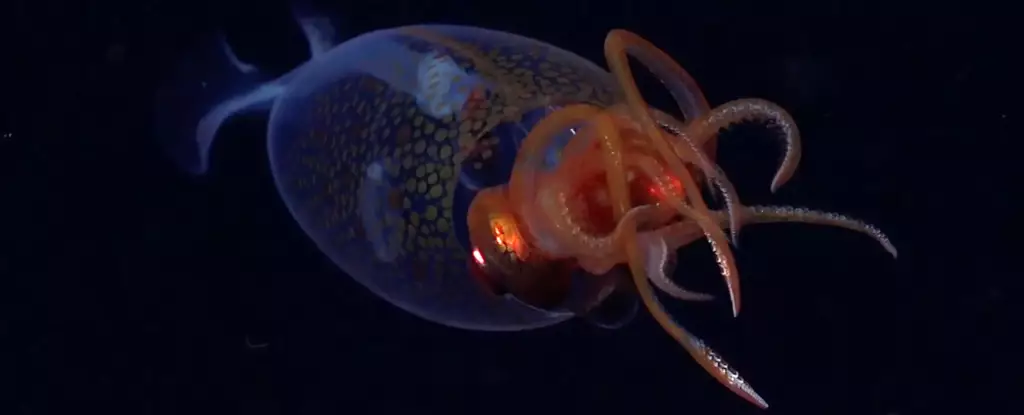The mysterious realm of the deep ocean has always held an allure that captivates humanity’s imagination. Yet within that dark abyss, few creatures elude our understanding as profoundly as the colossal squid. Recent revelations by a group of intrepid scientists shine a light on this enigmatic being, furthering the narrative not only of marine biology but also of our relationship with nature. The colossal squid, a creature that dwarfs its storied giant cousin, has resided in the untouched depths of the Antarctic for centuries, taunting researchers with its sheer existence.
For more than a century, the colossal squid has evoked both fear and fascination, much like the ancient tales of ocean monsters. Before this recent footage, our knowledge of the squid was limited to remnants found in the stomachs of its predators and fleeting glimpses of dying specimens surfacing near fishing vessels. This illuminating encounter is not merely a scientific triumph; it’s a reflection of our ongoing struggle to comprehend the natural world that exists beyond our reach.
The Epic Encounter
Captured through a remotely operated vehicle named SuBastian, the recent footage of a living juvenile colossal squid is nothing short of exhilarating. Recorded at nearly 600 meters deep, this is the first time we have ever seen a colossal squid in its natural habitat, lending a new level of visibility to an otherwise shadowy life. Researchers aboard the vessel “Falkor (too)” embarked on a mission for the Ocean Census, pulling back the veil on a creature that has essentially been a ghost in the underwater realm.
Kat Bolstad, a researcher deeply invested in the study of deep-sea cephalopods, calls this moment “one of the most exciting observations” of her career. This mix of excitement and reverence reflects a deep-seated recognition of our limitations as humans before the vastness of nature. Bolstad’s encounter reiterates that while we may think we know our oceans, the reality is that they are teeming with life forms that challenge our very understanding of existence.
Anatomy of a Wonder
The colossal squid’s unique anatomy further accentuates its status as a creature of wonder. These beings are not just another marine animal; they are the largest invertebrates known to exist, reaching eye-popping dimensions that could invoke myths—up to 23 feet in length and weighing nearly 1,100 pounds. The hooks on their tentacles and arms serve a structural purpose beyond mere predation. They adapt to the dark underbelly of the ocean, allowing the colossal squid to master its environment in ways we still struggle to comprehend.
This newly captured video reveals intricate details long hidden from human eyes. As Bolstad noted, this sighting allowed researchers to identify and confirm features that are signature to colossal squids, including the hooks on their arms—an ingenious adaptation that distinguishes them from others in their family.
Conversations on Conservation
As we marvel at the colossal squid, we must also reflect on what their existence tells us about the health of our oceans. These remarkable creatures thrive in depths that remain largely untouched by human activity, yet their populations may be vulnerable to climate change and overfishing in ways we do not yet fully understand. This newfound visibility through scientific exploration brings forth a responsibility to address our ecological footprint and advocate for the preservation of these elusive beings.
The encounter with the juvenile colossal squid embodies more than just a scientific milestone; it symbolizes our need for a deeper understanding of the ocean and a renewed commitment to protect its inhabitants. Such discoveries spark conversations about conservation efforts that are crucial in the face of an ever-changing climate.
A Catalyst for Inquiry
The newfound footage of the colossal squid serves as a catalyst for inquiry and exploration, pushing the boundaries of marine research further than ever before. It expands the dialogue on how we see ourselves within this vast ecosystem and questions the assumptions we hold about life beneath the waves. The beauty of deep-sea creatures is not just in their oddity but in the intricate balance they maintain within their environments—a balance that we, as the dominant species, must strive to understand and protect.
As we continue to probe the mysteries of the ocean depths, let us remain reminded that each discovery leads us closer to understanding ourselves and our place in the natural world. The colossal squid, once an undiscovered mystery, now encourages us to be smarter, more compassionate stewards of our planet, urging us to dive deeper—not just into the oceans, but into our commitment to safeguard the world around us.


Leave a Reply